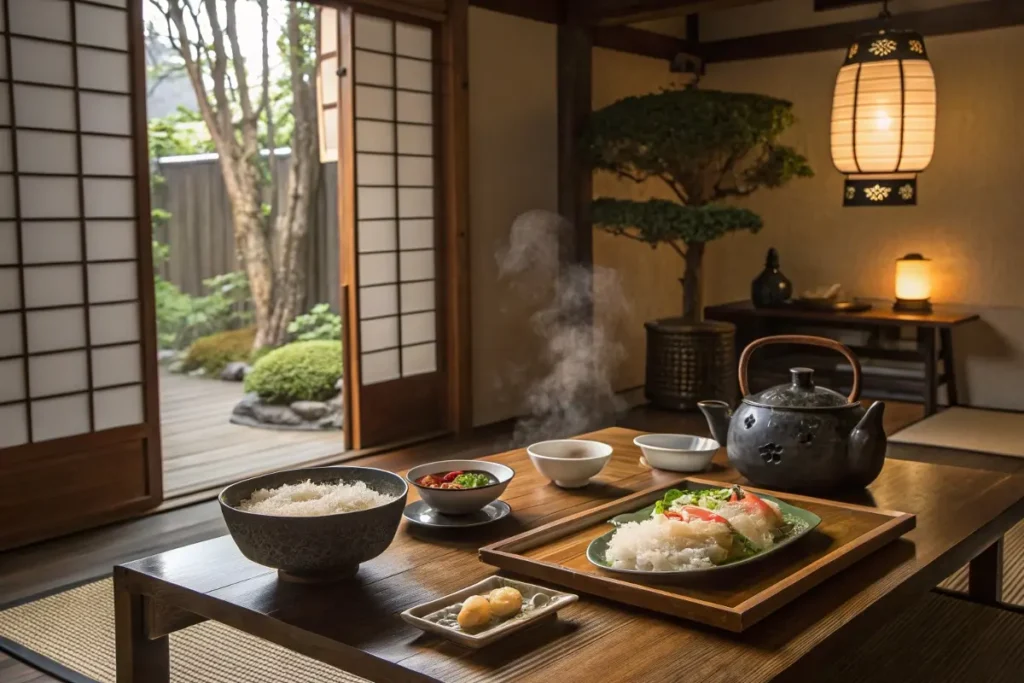Are you looking to bring the flavors of Japan into your kitchen? Japanese recipes are more popular than ever, beloved for their balance of fresh ingredients, umami flavors, and artistic presentation. Whether you’re new to this cuisine or a seasoned home cook, this guide will help you explore everything from easy japanese food and japanese dinner ideas to elaborate feasts and vegetarian options. By understanding the essential techniques and ingredients, you can recreate japanese home cooking recipes that capture tradition while suiting modern lifestyles.
For an even broader perspective on how to plan delicious Japanese-inspired meals, visit our Japanese Chicken Fried Rice Recipe—a simple dish that showcases how rice, vegetables, and protein come together harmoniously in Japanese cuisine. Let’s dive into the world of Japanese cooking and discover the possibilities that lie ahead.
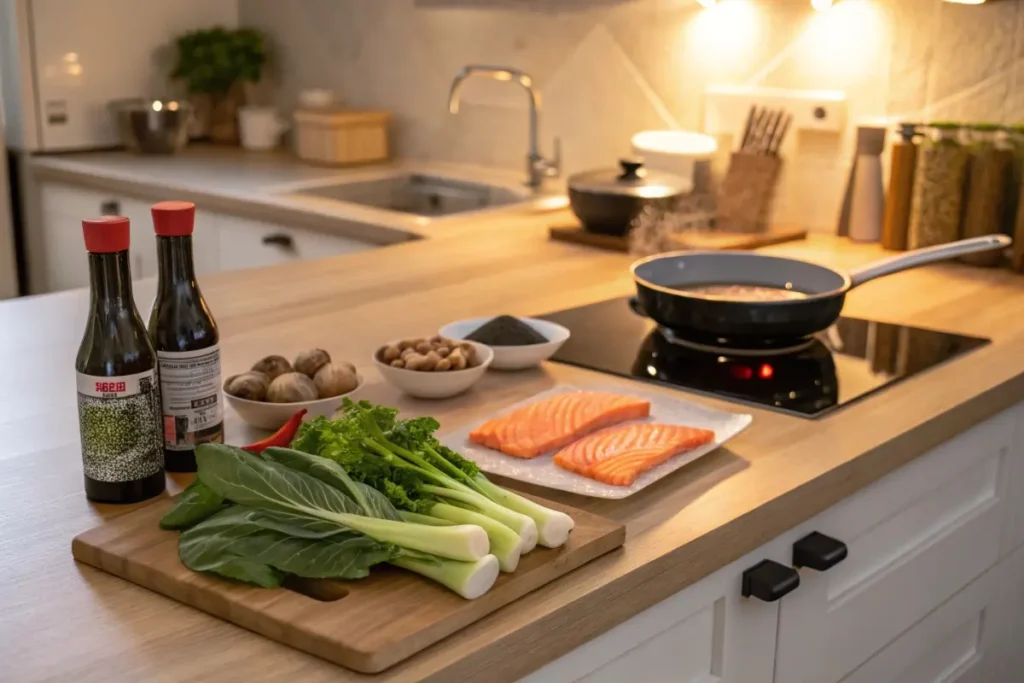
Core Elements of Japanese Cooking
To appreciate japanese recipes, it’s vital to understand the core elements that shape the cuisine. These foundational building blocks influence not only what appears on your plate but also the aroma and mouthfeel of each dish.
1. Dashi – The Umami Essence
- What is Dashi?
Dashi is a simple broth made from kombu (dried kelp), bonito flakes (katsuobushi), or a combination of both. It forms the backbone of many soups, sauces, and stews in Japanese cooking, providing a subtle yet deeply savory flavor. - Usage:
- Miso Soup: Classic comfort dish made with miso paste stirred into warm dashi.
- Sauces and Marinades: Enhances stir-fries and braises.
2. Soy Sauce, Miso, and Other Essential Seasonings
- Soy Sauce (Shoyu): A versatile, salty seasoning used in marinades, dipping sauces, and soups.
- Miso Paste: Made from fermented soybeans, this paste ranges from sweet (white miso) to robust (red miso).
- Mirin: A sweet rice wine that adds a subtle sweetness, balancing out salty or savory elements.
- Rice Vinegar: Used for pickling, dressings, or creating tangy sushi rice.
3. Rice and Noodles
- Short-Grain Rice: The heart of japanese recipes with rice. Sticky enough to hold its shape, making it perfect for sushi, onigiri (rice balls), or served plain as a side.
- Noodles (Ramen, Udon, Soba): Integral to easy japanese meals. Each type of noodle pairs with distinct broths and toppings, creating endless varieties.
4. Fresh Vegetables and Proteins
- Vegetables: Common choices include daikon radish, bok choy, eggplant, and seaweed varieties like wakame.
- Proteins: Fish, seafood, chicken, tofu, and beef frequently feature in Japanese cooking. Even minimal amounts can enrich a dish when paired with other ingredients.
5. Presentation and Mindfulness
- Balance of Colors: Japanese meals often incorporate five colors—red, green, yellow, white, and black—to create visual appeal.
- Portion Control: Smaller servings encourage mindful eating and let each ingredient’s flavor shine.
These core elements work in harmony to create everything from the best japanese recipes to quick weeknight dinners. If you’re feeling inspired, try our Noodles Japanese Pan Noodles Recipe for a deeper dive into noodle-based dishes. By mastering dashi, soy sauce, miso, and careful plating, you’ll unlock the signature tastes that define japanese dishes to make at home.
Easy Japanese Food for Beginners
Many newcomers assume japanese recipes are difficult, requiring specialized tools or techniques. Fortunately, there’s an abundance of easy japanese meals perfect for novices. With accessible ingredients and simple steps, these recipes highlight Japan’s flair for turning everyday items into culinary delights.
1. Miso Soup
- Why It’s Easy:
You only need miso paste, dashi (or even instant dashi packets), and a handful of add-ins like tofu cubes or seaweed. - Steps:
- Heat dashi.
- Dissolve miso paste in a small amount of warm stock.
- Combine and gently simmer.
- Serve with: Steamed rice and maybe a side of pickled vegetables.
2. Teriyaki Chicken
- Key Ingredients:
- Chicken thighs, soy sauce, mirin, sugar, ginger.
- Steps:
- Marinate chicken in a teriyaki sauce.
- Pan-fry until caramelized.
- Add leftover marinade until it thickens.
- Tip: Use the sauce as a glaze and pair it with steamed veggies or a salad.
3. Onigiri (Rice Balls)
- Why It’s Easy:
Shaping warm rice into triangular or round molds is more straightforward than it looks. Stuff them with tuna mayo, pickled plum (umeboshi), or salmon flakes. - Practical Use: Perfect for lunchboxes or quick snacks.
4. Vegetarian Sushi Rolls
- Fillings:
- Avocado, cucumber, carrots, tofu, and sushi rice.
- Method:
- Place nori sheet on a bamboo mat.
- Spread sushi rice.
- Layer vegetables and roll tight.
- Alternative: For a lighter twist, try a sushi burrito with extra veggies.
5. Tofu Steak
- Why It’s Beginner-Friendly:
Tofu is forgiving—you can pan-sear or grill it without concern for overcooking. - Flavor Boost: Top with grated daikon, soy sauce, or ponzu for tanginess.
These easy dishes showcase a range of flavors—from sweet and savory teriyaki to mild, comforting miso soup—proving that japanese recipes easy don’t sacrifice taste. You can also discover how Japanese cuisine accommodates various dietary preferences, like in our Vegan Japanese Recipes collection, which highlights plant-based adaptations of classic favorites. With the fundamentals down, you’ll be ready for more advanced fare in no time.
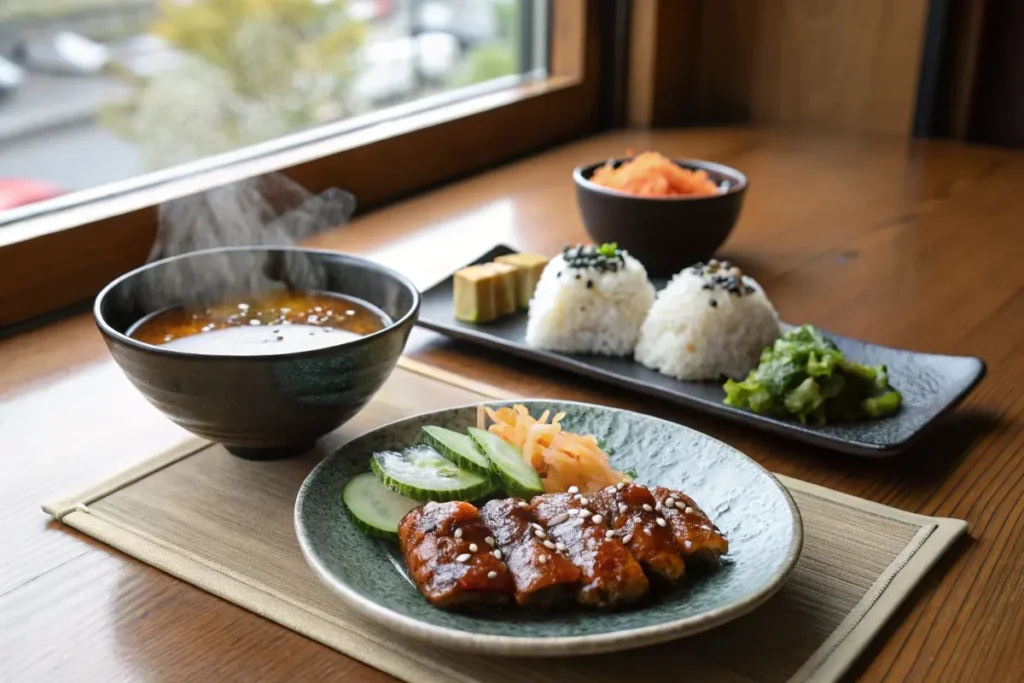
Best Japanese Recipes for Dinner
When planning an evening meal, look no further than japanese dinner ideas that deliver both comfort and sophistication. These dishes range from warming soups to hearty one-pot meals, ensuring you never run out of options for family dinners or entertaining guests.
1. Sukiyaki
- What is It?
A simmered hot pot dish often prepared tableside. Thin slices of beef, tofu, vegetables, and glass noodles cook in a mix of soy sauce, sugar, and mirin. - Why It’s a Dinner Staple:
- Social aspect: Everyone gathers around one pot.
- Balanced meal: Protein, veggies, and noodles in one dish.
2. Japanese Curry
- Flavor Profile:
Creamy and mildly sweet, with a gentle spice. - Key Ingredients:
- Curry roux blocks, onions, carrots, potatoes, and your choice of protein (chicken or beef).
- Tip: For a unique spin, try our Japanese Curry Recipe One Piece to replicate anime-inspired comfort food.
3. Yakisoba
- Noodle Dish:
Stir-fried noodles with vegetables, sliced pork (optional), and a tangy-sweet sauce. - Serving Suggestion:
Top with pickled ginger or a sprinkle of seaweed flakes for a pop of color.
4. Salmon Teriyaki
- Go-To Fish Dish:
A thick fillet of salmon brushed with a homemade teriyaki sauce. - Serving Idea:
Serve with a side of steamed rice and grilled vegetables. The sweet-salty glaze pairs beautifully with the rich flavor of salmon.
5. Tonkatsu (Breaded Pork Cutlet)
- Crispy & Hearty:
Pork loin cutlets breaded in panko and deep-fried. - Sauce:
Tonkatsu sauce is a must, often tangy and slightly sweet. - Variation: Chicken katsu, if you prefer poultry.
For a well-rounded dinner, always include a small side of miso soup or a fresh salad. Japanese dinners often incorporate a variety of tastes and textures—crunchy pickles, silky tofu, or crisp tempura, for instance. To add more depth to your menu, visit our Japanese Scallop Recipe for an elegant seafood option. By mixing and matching these best japanese recipes, you’ll keep your table exciting, nutritious, and undeniably delicious.
Exploring Vegetarian and Vegan Japanese Dishes
Traditionally, Japanese cuisine has always integrated vegetables, seaweed, and soy-based products. This makes it exceptionally adaptable for those seeking japanese recipes vegetarian or vegan-friendly. Here’s how you can enjoy the flavors of Japan without meat or fish.
1. Shojin Ryori – Buddhist Temple Cuisine
- Philosophy:
Developed by Buddhist monks avoiding meat, garlic, and onions. - Typical Dishes:
- Vegetable Tempura: Thinly sliced bell peppers, sweet potato, or mushrooms, lightly battered and fried.
- Eggplant Dengaku: Grilled eggplant topped with sweet miso glaze.
2. Plant-Powered Sushi Rolls
- Fillings:
Avocado, cucumber, pickled radish, tofu, or asparagus. - Flavor Boost:
Wasabi, soy sauce, or a drizzle of sesame oil to enrich vegetarian fillings.
3. Miso Eggplant
- Method:
- Sauté or grill eggplant halves.
- Spread miso glaze made from miso paste, mirin, and sugar.
- Broil until caramelized on top.
- Result: Tender, savory-sweet dish that’s perfect with rice.
4. Tofu Steaks and Stir-Fries
- Versatile Base:
High-protein tofu can be pan-fried, baked, or grilled. - Sauce Options:
Teriyaki, ponzu, or even a miso-based marinade.
5. Nabe (Hot Pot) with Vegetables
- Hearty Soup:
Combine bok choy, napa cabbage, carrots, mushrooms, and tofu in a flavorful broth. - Dipping Sauce:
Ponzu or sesame-based dip completes the experience.
To accommodate vegetarian or vegan preferences while maintaining authenticity, choose seasonings like mushroom or kelp-based dashi instead of fish-derived versions. You can explore an array of plant-forward recipes in our Vegan Japanese Recipes section, which proves that Japanese cuisine offers rich, umami flavors even without animal products.
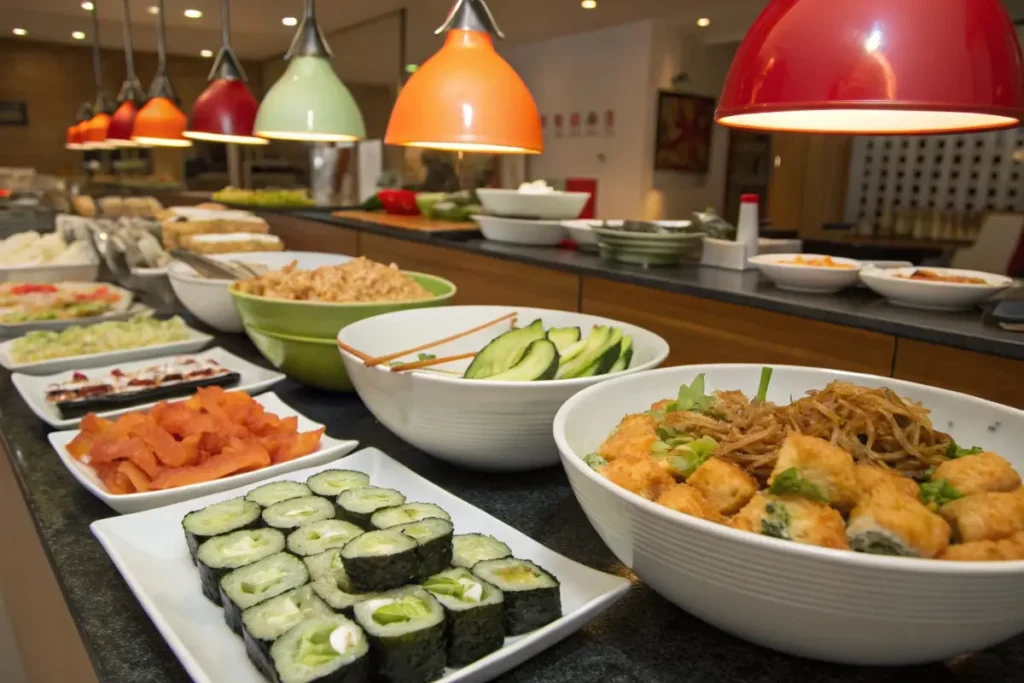
Rice at the Heart of Japanese Home Cooking
For centuries, rice has been central to japanese home cooking recipes, reflecting culture, tradition, and nutrition. Beyond being a side dish, rice can be the star ingredient in countless forms—from sushi to comforting bowls. Here’s why it remains indispensable.
1. Types of Japanese Rice
- Short-Grain White Rice:
Offers a sticky, slightly sweet texture, perfect for sushi and japanese recipes with rice. - Brown Rice:
A healthful choice, retaining more nutrients and fiber. - Mixed Grains:
Sometimes rice is combined with barley or millet for added texture and nutrition.
2. Mastering the Perfect Rice
- Washing Technique:
Gently rinse the grains until the water runs clear, removing excess starch. - Water Ratio:
Typically, 1:1.1 or 1:1.2 (rice to water) for white rice, adjusted based on preference. - Cooking Methods:
Rice cooker is the norm in Japanese households, but stovetop methods also work. Let it steam after cooking for optimal fluffiness.
3. Japanese Dishes to Make with Rice
- Sushi:
- Roll rice with nori sheets, fish, or vegetables for a quick lunch or dinner.
- Season with vinegar, sugar, and salt for that signature sushi rice taste.
- Donburi (Rice Bowls):
- Toppings like beef (gyudon), chicken (oyakodon), or tempura (tendon).
- Each variation provides a balanced meal in a single bowl.
- Fried Rice (Chahan):
- Leftover rice is stir-fried with eggs, veggies, and protein.
- Check out our Japanese Chicken Fried Rice Recipe for a straightforward approach.
- Omurice:
- A fusion dish where seasoned fried rice is wrapped in a thin omelet, often topped with ketchup or demi-glace sauce.
4. Preservation and Leftovers
- Onigiri:
Use leftover rice to form rice balls stuffed with pickled plum, salmon, or tuna mayo. They store well in the fridge. - Congee (Okayu):
Turn leftover rice into a porridge by simmering in extra water or dashi.
5. Health Benefits
- Energy Source:
Carbohydrates from rice provide sustained energy. - Low Fat:
Prepared without heavy oils or butter, making it easier to digest. - Versatility:
Suitable for gluten-free diets and pairs well with diverse ingredients.
This focus on rice underpins many easy japanese meals, bridging gaps between novice home cooks and experts alike. For additional inspiration, see our article on Japanese Dessert Recipes to explore how rice flour and sweet glutinous rice are used in treats like mochi. Ultimately, mastering rice is the key to unlocking the full potential of Japanese cuisine.
History/Context of Japanese Recipes
Japanese cuisine has evolved over centuries, shaped by geography, cultural exchange, and dietary needs. Understanding this history enriches your appreciation of japanese recipes, adding cultural depth to each dish.
Ancient Influences
- Rice Cultivation:
Rice farming dates back over 2,000 years, quickly becoming Japan’s staple crop and primary energy source. Villages would celebrate harvest seasons with festivals, signifying rice’s importance. - Shinto and Buddhist Rituals:
Shinto worship often involved offerings of rice, salt, and sake to deities. Meanwhile, Buddhism promoted a plant-based diet, influencing vegetarian dishes such as shojin ryori.
Feudal Era and Samurai Culture
- Samurai Diet:
Though largely agrarian, samurai warriors enjoyed better-quality rice, fish, and vegetables. The era introduced refined cooking techniques to the elite. - Regional Specialties:
Provinces began developing distinct local dishes, like miso in Nagoya or soy sauce production in various regions. Sea trade and fishing in coastal areas led to a fish-centric diet.
Edo Period (1603–1868)
- Urban Growth:
As major cities like Edo (now Tokyo) expanded, food stalls and restaurants catered to the masses. - Rise of Sushi:
Hand-pressed sushi (nigiri) gained popularity as a fast food, heralding the concept of best japanese recipes for busy lifestyles.
Meiji Restoration and Western Influence
- Modernization:
Western ideas and ingredients—bread, dairy, meat—entered the culinary scene. - Fusion Cuisine:
Dishes like tempura borrowed from Portuguese methods; katsu (breaded cutlets) followed Western breading and frying styles.
Post-War and Contemporary Trends
- Economic Boom:
Japan’s rapid growth made fresh ingredients and imported foods widely available, fostering creative japanese dinner ideas. - International Cuisine:
Japanese ramen, sushi, and tempura spread globally. Conversely, Western and Chinese elements became normalized in Japan.
Despite modernization, the core principles remain: balance of flavors (sweet, salty, sour, bitter, umami), mindful presentation, and high-quality ingredients. Even as convenience foods proliferate, there’s a renewed interest in traditional methods like fermenting (miso, soy sauce) and preserving local fish. For instance, you can see how these time-tested techniques appear in our Traditional Japanese Desserts Recipe—a testament to how tradition and innovation co-exist within Japan’s culinary landscape.
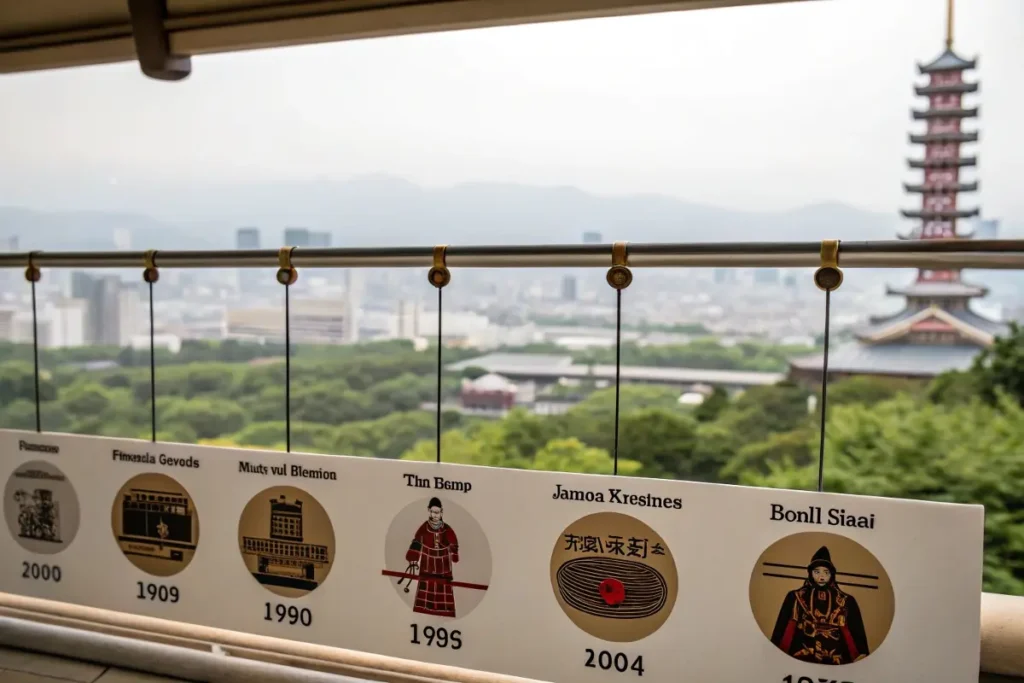
Practical Examples/Use Cases
Let’s explore how japanese recipes can fit seamlessly into various everyday scenarios. Whether you’re cooking for a family, managing a busy schedule, or hosting a themed dinner party, these examples demonstrate just how adaptable Japanese cuisine can be.
1. Weeknight Family Dinner
- Menu:
- Teriyaki Chicken
- Steamed Rice
- Miso Soup with Tofu and Wakame
- Why It Works:
Quick to prepare, high in protein, and appealing to diverse palates (even kids). - Pro Tip: Use leftover chicken for sandwiches or salad toppings the next day.
2. Impressing Guests
- Menu:
- Assorted Sushi Rolls (California rolls, spicy tuna rolls, veggie rolls)
- Yakisoba Stir-Fry
- Japanese Cheesecake as dessert
- Why It Works:
Visually stunning, interactive if guests want to customize sushi, and ends with a light, fluffy cake. - Suggested Resource: Japanese Dessert Recipes for sweet endings.
3. On-the-Go Lunch
- Menu:
- Bento Box with Onigiri, Tempura Vegetables, and Tamagoyaki (rolled omelet)
- Edamame or pickled cucumbers as sides
- Why It Works:
Portable, portion-controlled meals ideal for work or school. - Easy Variation: Substitute tamagoyaki with tofu slices for a vegetarian bento.
4. Quick Meal Prep
- Menu:
- Basic Fried Rice (chahan) using leftover vegetables and proteins
- Miso Soup (ready in minutes with instant dashi)
- Why It Works:
Efficient use of leftovers while ensuring a healthy, flavorful meal. - Try This: Our Japanese Chicken Fried Rice Recipe simplifies the process for busy days.
5. Celebratory Feasts
- Menu:
- Sukiyaki or Shabu-Shabu Hot Pot
- Assorted Sashimi Platter
- Mochi Ice Cream for dessert
- Why It Works:
Creates a communal dining experience where guests interact with the cooking process, making it both entertaining and delicious.
Japanese cuisine caters to a multitude of lifestyles—health enthusiasts, families, vegetarians, or adventurous foodies. With basic staples like dashi, soy sauce, and fresh produce, you can craft endless japanese dinner or lunch variations. Turn to our Japanese Vegan Recipes if you or your guests follow a plant-based diet, ensuring no one misses out on the umami-packed fun.
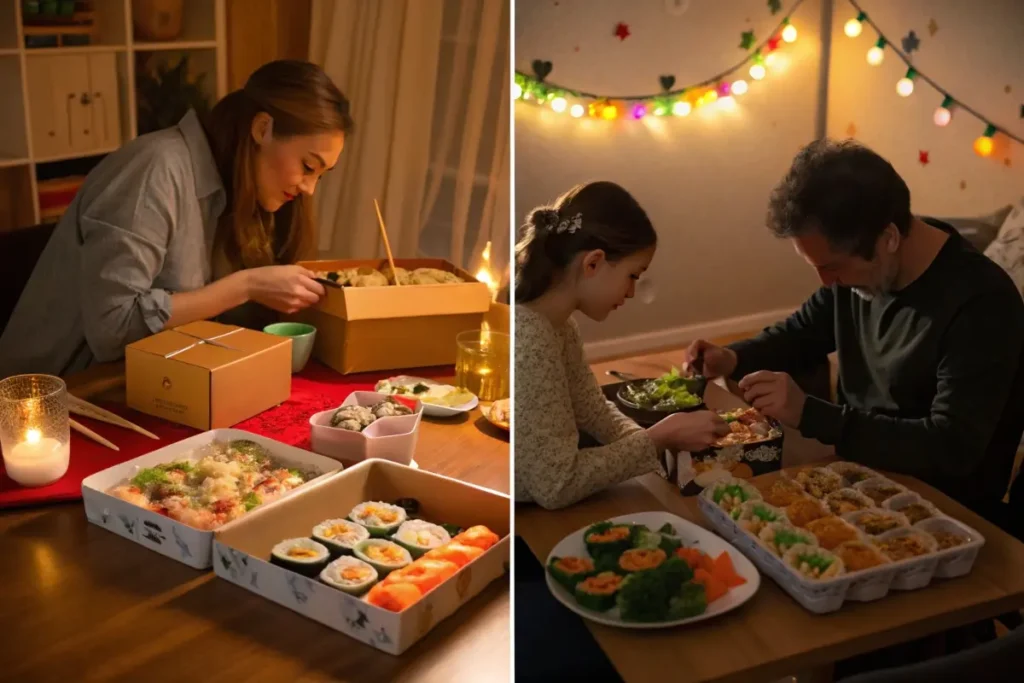
FAQs
Curious about japanese recipes? Here are answers to frequently asked questions people often have when diving into this flavorful cuisine.
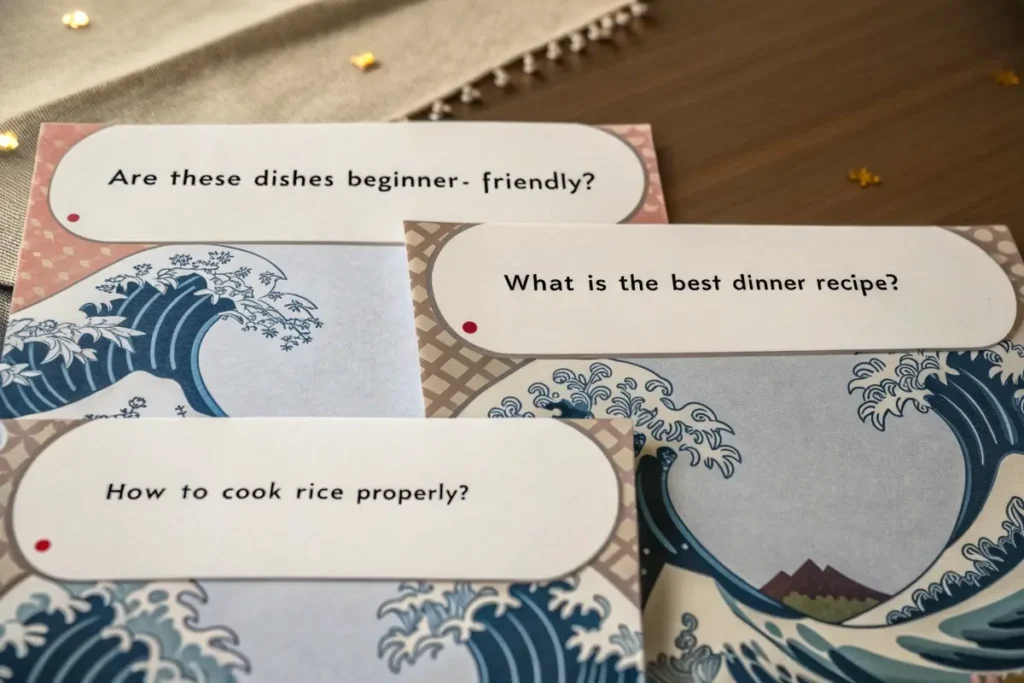
- What are traditional Japanese recipes?
Traditional Japanese recipes focus on fresh, often local ingredients like fish, rice, and seasonal vegetables. Dishes include sushi, tempura, miso soup, and pickled vegetables. Many follow the concept of ichiju-sansai (one soup, three sides) to maintain nutritional balance. - Are Japanese recipes easy for beginners?
Yes. Many easy japanese meals like miso soup, onigiri (rice balls), and teriyaki chicken are straightforward. The key is sourcing quality ingredients and understanding basic techniques like cooking rice or mixing dashi. - What is the best Japanese dish for dinner?
It depends on your preference. Some popular choices are sukiyaki hot pot, Japanese curry, and salmon teriyaki. For a communal feel, hot pot dishes (like shabu-shabu) are fun and interactive, especially for groups. - Do Japanese recipes accommodate vegetarian or vegan diets?
Absolutely. Japanese recipes vegetarian options abound—think tofu, vegetable tempura, and sushi rolls with avocado or pickled radish. Traditional Buddhist temple cuisine (shojin ryori) omits meat, fish, garlic, and onions entirely. - Are there simple Japanese recipes for chicken?
Indeed. Teriyaki chicken, chicken katsu, and Japanese fried chicken (karaage) are easy crowd-pleasers. These can be served with rice and a side of fresh vegetables for a balanced meal. - How do I make Japanese rice properly?
Rinse short-grain rice until the water runs clear. Then use a rice cooker or stovetop method with the correct water ratio (usually around 1:1.1). Let the rice rest or steam for a few minutes after cooking to ensure fluffiness. - Where can I find Japanese recipes for dinner with minimal ingredients?
Check out our Steak Japanese Recipe or Minced Beef Japanese Recipe for simple but flavorful meals. Both require minimal pantry items yet pack an umami punch.
Tips to Start Your Culinary Journey
By answering these common questions, you can start your journey with confidence, whether you aim to replicate japanese recipes with rice or try your hand at more elaborate fusion menus. Always remember to adjust seasonings—like soy sauce and mirin—to match your taste preferences, and explore different garnishes (sesame seeds, pickled ginger) for an authentic finish.
Conclusion
From easy japanese meals you can whip up on a weeknight to intricate hot pots for special occasions, japanese recipes offer versatility, nutrition, and that unmistakable umami. By understanding core elements—like dashi, rice preparation, and proper seasoning—you’re already well on your way to mastering this cuisine. Whether you’re planning a family dinner, looking for vegetarian adaptations, or simply craving the comforting warmth of miso soup, Japan’s culinary landscape has you covered.
The joy of Japanese cooking lies in its balance: a harmony of taste, texture, and presentation. Each meal embodies a careful consideration of ingredients, preparation methods, and aesthetics, inviting us to be more mindful with our cooking. Ready to deepen your exploration? We encourage you to Discover Japanese Recipes across various categories—from ramen and bento to desserts and festival specialties.
By incorporating these dishes into your repertoire, you’ll not only satisfy your taste buds but also gain insight into a culture that places food at the center of community and well-being. Thank you for joining us on this flavorful journey. Now, it’s time to roll up your sleeves, gather your ingredients, and immerse yourself in the delightful world of Japanese cooking.
